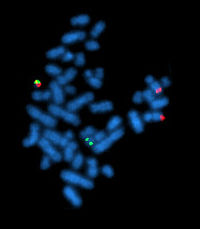
Photo from wikipedia
Isochromosome 17q (i17q) is a commonly encountered chromosomal abnormality in myeloid neoplasms (MN) where there is a loss of 17p and duplication of 17q – leading to a single copy… Click to show full abstract
Isochromosome 17q (i17q) is a commonly encountered chromosomal abnormality in myeloid neoplasms (MN) where there is a loss of 17p and duplication of 17q – leading to a single copy of 17p and three copies of 17q. It is found most commonly in combination with other chromosomal abnormalities (complex cytogenetics) and rarely as a sole mutation. Isochromosome 17q is seen in a variety of disorders such as Philadelphia positive (Ph+ ) Chronic Myeloid Leukemia (CML), Acute Myeloid Leukemia (AML), Hodgkin and non-Hodgkin lymphomas and myeloproliferative neoplasms (MPN) including MDS/MPN overlap syndromes. It is considered to be associated with poor prognosis and may have unique clinicopathological features. [1,2]. The aim of our study was to identify patients with myeloid neoplasms with i17q mutations (sole or with complex cytogenetics) and analyze their clinical characteristics and treatment outcome in a single center setting. We retrospectively identified patients with bone marrow biopsy proven myeloid neoplasms with i(17)(q10) mutations. This data was collected from the University of Kansas Cancer Center database between 2011 and 2017. We obtained patient demographics, the clinical course of their disease, diagnosis, and treatment regimens. Patients with insufficient data were excluded. Patient characteristics are shown in Table 1. Fourteen patients were identified with myeloid neoplasms with i17q. Twelve patients had associated complex cytogenetics while the remaining 2 patients had i17q as a sole abnormality. Five patients had de novo occurrence of i17q myeloid neoplasms while 9 had secondary evolution from a previously diagnosed myeloid neoplasm. Two of the 5 patients with de novo i17q neoplasms had i17q as the sole cytogenetic abnormality. This constituted 1 case of AML and 1 case of MDS/MPN. Secondary evolution of a previous i17q negative neoplasm to one with i17q positive most commonly occurred in patients with CML (n=4), during blast crisis. The median overall survival was 10.4 months with a maximum duration of follow up of 102.4 months for the entire cohort (Fig. 1). Four patients underwent hematopoietic stem cell transplantation (HSCT) and had a median survival of 42 months (range: 20–90.3) while non-transplanted patients (n=10) had a median survival of 9.4 months (range: 2.9–102.4). Three out of 4 patients who underwent HSCT were alive at the time of data collection. During the period of 2011 to 2017, we found 14 patients with i17q (either sole or with complex cytogenetic abnormalities) with a median survival of 10.4 months. Isochromosome 17q is often seen as a secondary evolution during blast crisis phase of CML and other myeloid neoplasms as reported in the literature and heralds an aggressive clinical course [3,4] Isochromosome 17q is associated with a poor prognosis in patients with myeloid neoplasms. [5,6] An improved survival trend was noted in our patients who underwent HSCT compared to those patients who were managed by traditional chemotherapy only. Due to low number of patients, a statistical difference in survival (HSCT vs non-HSCT) was not seen in our sample. We propose to explore the role of HSCT in patients with i17q using a larger platform like Center for International Blood and Marrow Transplant Research (CIBMTR) in future.
Journal Title: Leukemia Research Reports
Year Published: 2018
Link to full text (if available)
Share on Social Media: Sign Up to like & get
recommendations!